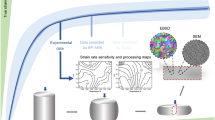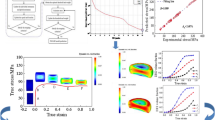Abstract
The true stress–strain curve of the thermal deformation of 30Cr2Ni4MoV steel was obtained by conducting a hot compression experiment. On the basis of the results, the constitutive equation of the material’s thermal deformation was constructed. Then, the microstructure of the hot compression specimen was observed and analyzed, and the microstructure evolution model of 30Cr2Ni4MoV steel during thermal deformation was established accordingly. The programming of the related mathematical model was realized using the secondary development interface provided by Deform. The experimental plan was subsequently developed using an orthogonal method, and the microstructure evolution of 30Cr2Ni4MoV steel during multi-directional forging deformation was simulated. Through an orthogonal experiment analysis, the influence weight difference of each influencing factor was obtained. A back propagation neural network prediction model for the microstructure of 30Cr2Ni4MoV steel under multi-directional forging deformation was then established. The neural network prediction of the microstructure evolution of 30Cr2Ni4MoV steel under multi-directional forging was finally realized.














Similar content being viewed by others
Availability of data and material
The datasets used or analyzed during the current study are available from the authors on reasonable request.
Code availability
The raw/processed data required to reproduce these findings cannot be shared at this time as the data also forms part of an ongoing study.
References
He JL, Cui ZS, Chen F, Xiao YH, Ruan LQ (2013) The new ductile fracture criterion for 30Cr2Ni4MoV ultra-super-critical rotor steel at elevated temperatures. Mater Des 52:547–555
Chen F, Cui ZS, Sui DS, Fu B (2012) Recrystallization of 30Cr2Ni4MoV ultra-super-critical rotor steel during hot deformation. Part Ш: metadynamic recrystallization. Mater Sci Eng, A 540:46–54
Chen F, Cui ZS, Chen SJ (2011) Recrystallization of 30Cr2Ni4MoV ultra-super-critical rotor steel during hot deformation. Part I: dynamic recrystallization. Mater Sci Eng A 528(15):5073–5080
Zhang XZ, Liu ZL, Liu JS, Dang SE (2020) Evolution and evaluation of duplex grain of as-cast 30Cr2Ni4MoV steel during heat treatment. Mater Sci 26(3):281–286
Zhou P, Ma QX (2017) Dynamic recrystallization behavior and constitutive modeling of as-Cast 30Cr2Ni4MoV steel based on flow curves. Met Mater Int 23(2):359–368
Zhu QF, Li L, Ban CY, Zhao ZH, Zuo YB, Cui JZ (2014) Structure uniformity and limits of grain refinement of high purity aluminum during multi-directional forging process at room temperature. Trans Nonferrous Met Soc China 24(5):1301–1306
Kavosi J, Saei M, Kazeminezhad M, Dodangeh A (2014) Modeling of dislocation density and strength on rheoforged A356 alloy during multi-directional forging. Comput Mater Sci 81:284–289
Zhang ZX, Qu SJ, Feng AH, Shen J (2017) Achieving grain refinement and enhanced mechanical properties in Ti–6Al–4V alloy produced by multidirectional isothermal forging. Mater Sci Eng A 692:127–138
Miura H, Maruoka T, Yang X, Jonas JJ (2012) Microstructure and mechanical properties of multi-directionally forged Mg–Al–Zn alloy. Scr Mater 66(1):49–51
Gao ZY, Grandhi RV (2000) Microstructure optimization in design of forging processes. Int J Mach Tool Manuf 40(5):691–711
Chamanfar A, Valberg HS, Templin B, Plumeri JE, Misiolek WZ (2000) Development and validation of a finite-element model for isothermal forging of a nickel-base superalloy. Materialia 6:100319
Srinivasan R, Ramnaraya NV, Deshpande U, Jain V, Weiss I (1993) Computer simulation of the forging of fine grain IN-718 alloy. Metall Trans A 24(9):2061–2069
Qian DS, Pan Y (2013) 3D coupled macro–microscopic finite element modelling and simulation for combined blank-forging and rolling process of alloy steel large ring. Comput Mater Sci 70:24–36
He A, Wang XT, Xie GL, Yang XY (2015) Modified Arrhenius-type constitutive model and artificial neural network-based model for constitutive relationship of 316 LN stainless steel during hot deformation. J Iron Steel Res Int 22(8):721–729
Jin YB, Hao X, Yang ZY, Zhang LL, Zhang CX, Wang SR, Luo JT (2019) Constitutive equation of GH4169 superalloy and microstructure evolution simulation of double-open multidirectional forging. Metals 9(11):1146
Fang S, Liu Z, Yi W, Shi Z (2010) Finite element simulation of machining of Ti-6Al-4V alloy with thermodynamical constitutive equation. Int J Mach Tools Manuf 49(5–8):431–439
Park NK, Kim IS, Na YS, Yeom JT (2001) Hot forging of a nickel-base superalloy. J Mater Process Technol 111(1–3):98–102
Kermanpur A, Tin S, Lee PD, Mclean M (2004) Integrated modeling for the manufacture of aerospace discs: grain structure evolution. JOM 56(3):72–78
Guo Q, Yan HG, Chen ZH, Zhang H (2007) Grain refinement in as-cast AZ80 Mg alloy under large strain deformation. Mater Charact 58(2):162–167
Bahmani A, Arthanari S, Shin KS (2000) Improved corrosion resistant and strength of a magnesium alloy using multi-directional forging (MDF). Int J Mach Tools Manuf 105(1–4):785–797
Miura H, Yu G, Yang X (2011) Multi-directional forging of AZ61Mg alloy under decreasing temperature conditions and improvement of its mechanical properties. Mater Sci Eng A 528(22–23):6981–6992
Wu GP, Wang SA, Huang W, Liu TH, Yin Y, Liu YH (2016) Application of BP and RBF neural network in classification prognosis of hepatitis B virus reactivation. Proc 2016 Int Conf Electr Eng Comput Sci (ICEECS2016) 54–58
Sun ZC, Wang XQ, Zhang J, Yang H (2014) Prediction and control of equiaxed α in near-β forging of TA15 Ti-alloy based on BP neural network: for purpose of tri-modal microstructure. Mater Sci Eng A 591:18–25
Funding
This project is supported by the Natural Science Foundation of Hebei Province, China (Grant No. E2019203005).
Author information
Authors and Affiliations
Contributions
Junting Luo contributed to the conception of the study. Jingqi Zhao performed the data analyses and wrote the manuscript. Zheyi Yang made an important contribution to the simulation and data analysis process. Yongbo Jin performed the experiment. Chunxiang Zhang helped perform the analysis with constructive discussions.
Corresponding author
Ethics declarations
Ethics approval
The paper is original and has not been published before and is not currently being considered for publication elsewhere.
Consent to participate
All the authors listed agree to participate.
Consent for publication
All the authors listed agree to publish.
Conflict of interest
The authors declare no competing interests.
Additional information
Publisher's note
Springer Nature remains neutral with regard to jurisdictional claims in published maps and institutional affiliations.
Rights and permissions
About this article
Cite this article
Luo, J., Zhao, J., Yang, Z. et al. Microstructure prediction of multi-directional forging for 30Cr2Ni4MoV steel by the secondary development of Deform software and BP neural network. Int J Adv Manuf Technol 119, 2971–2984 (2022). https://doi.org/10.1007/s00170-021-08615-w
Received:
Accepted:
Published:
Issue Date:
DOI: https://doi.org/10.1007/s00170-021-08615-w




